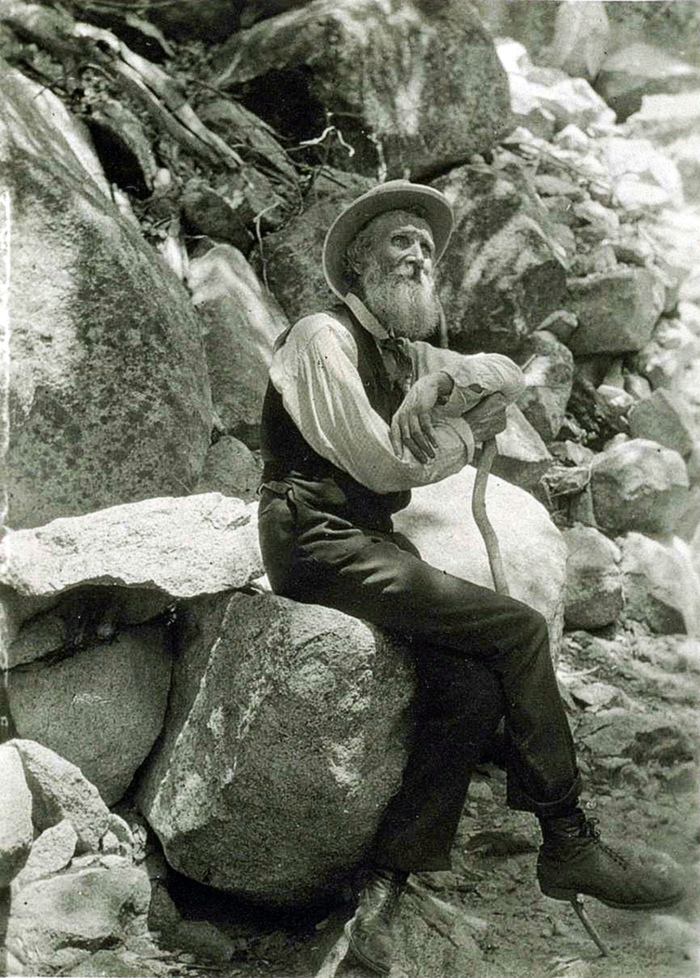Wild Words: John Muir, Writer
John Muir used his letters, journals, articles for newspapers and magazines and 12 books to persuade people to protect the environment
 John Muir, Writer is a Friends’ of John Muir’s Birthplace’s exhibition. The following excerpt shows how Muir developed his writing skills.
John Muir, Writer is a Friends’ of John Muir’s Birthplace’s exhibition. The following excerpt shows how Muir developed his writing skills.
John began school before his third birthday having learnt to read shop signs on Dunbar High Street during walks with his grandfather David Gilrye. His grandfather assisted with school homework and bible study. When the family emigrated to the New World in 1849 there were few schools in the back woods of Wisconsin and plenty of farm work for 11 year olds. John’s hunger for knowledge was fed by neighbours like fellow Scottish immigrant William Duncan who lent him books and this ultimately led to a place at the University of Wisconsin in 1860.
When John left home he took great enjoyment from writing letters and the conversations that he shared on paper. Initially his letters were to family but they developed into an exchange of thoughts with Jeanne Carr, wife of Muir’s chemistry professor Ezra Carr. Jeanne Carr encouraged the reluctant Muir to consider writing for publication. A letter to her appeared in Overland Monthly in January 1873 as A Geologist’s Winter Walk but under Muir’s name! Muir’s letter writing increased with leading scienists like Asa Gray and Charles Sargent of Harvard, J D Runkle of MIT and Sir Joseph Hooker of London’s Kew Gardens seeking his help. A typical Muir reply could easily exceed 1000 words.
Muir had started keeping journals following advice from his professor of classics James D Butler at the University of Wisconsin. Early journals from his time in Canada were lost in a fire at a factory where he worked, but 78 journals still survive and cover the years 1867 to 1913. Visitors to John Muir’s Birthplace, Dunbar, can see images from the journal that he kept during his 1000 mile walk from Indiana to the Gulf of Mexico and reference to the inscription in the fly leaf, “John Muir, Earth-planet, Universe.” The journals offer a unique perspective on Muir’s life and experiences in his own words and sketches. Muir used his journals extensively when writing My First Summer in the Sierra, published in 1911. His literary executor William Badè also used them as source material for A Thousand Mile Walk to the Gulf (1916) and others. In 1938 Muir biographer Linnie Marsh Wolfe produced a compilation of the best of his hitherto unpublished journal writings in John of the Mountains.
Muir started to reach a far wider public as his first article Yosemite Glaciers was published in the New York Tribune (1872) providing a valuable source of income. San Francisco’s Overland Monthly published three pieces; Boston’s Weekly Transcript published The Hetch Hetchy Valley; Overland Monthly began Muir’s Studies in the Sierra, 18 articles over two years; and Harper’s New Monthly Magazine, with national circulation, published four articles. Muir had become an established and popular nature writer. When the Sacramento Record Union published his essay God’s First Temples; How Shall We Preserve Our Forests? in 1876 Muir became a leader of the new conservation movement. Marriage and fruit farming bought a halt to all writing except letters in 1880, although editor Robert Underwood Johnston persuaded him to write two articles for Century in 1890 supporting the creation of Yosemite National Park.
Book writing did not come easily to Muir. In 1876 he wrote to his sister Sarah, “My life these days is like the life of a glacier, one eternal grind… My first book is taking shape now… I hope to see it in print, rubbed, and scrubbed, and elaborated, some time next year.” Mountains of California eventually appeared in 1894 to enthusiastic acclaim. Our National Parks followed in 1901, then a further four books. On Christmas Eve 1914 Muir died in a Los Angeles hospital, the unfinished manuscript of his Alaska book beside him.
Muir’s lasting literary legacy was secured in the books published after his death. Muir’s daughters invited Marion Randall Parsons to finish Muir’s Travels in Alaska. Muir’s literary editor William Frederic Badè worked tirelessly to bring Muir’s literary legacy to the public. Muir’s books have been seldom out of print and his life has attracted countless biographies and anthologies. Muir was awarded honorary degrees by Harvard, Yale and the Universities of California and Wisconsin. In 2014 John Muir became the 38th Scot to be recognised in Writers’ Court, Edinburgh. His flagstone carries a quotation from a letter to Jeanne Carr in 1874: “I care to live only to entice people to look at Nature’s loveliness.”
See the full 'John Muir, Writer' exhibition at our two Wild Word events in Keswick and Fort William.
The exhibition was inspired by the donation of three John Muir first edition books given to Friends of John Muir’s Birthplace by Ronnie Skea in celebration of his mother’s 100th birthday on 8 April 2014. These first edition books are now on permanent display at John Muir’s Birthplace thanks to a grant from Museums Galleries Scotland. For further details about the books or the exhibition visit John Muir’s Birthplace or contact Jo Moulin.
---
Celebrate our Wild Words month with this special offer: 25% off for your first year of John Muir Trust membership* if you join us during October 2019. Use the promo code: WILDWORDS (*Ts & Cs apply).